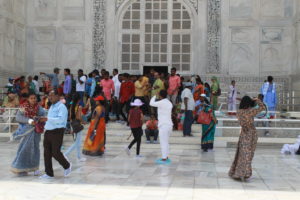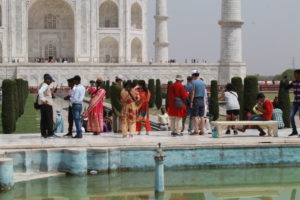 Yesterday I visited the Taj Mahal. What is to be said? As one iconic building burns in Paris, I don’t feel in the mood to be too cool about another, and it is a very beautiful building, mathematical, its famous ethereal quality seeming to me an effect of its abstraction. Like fractals, its shapes might suggest organic forms, but seem produced through the force of relentless equations. The Qur’anic verses on its walls were, as my Muslim guide pointed out, the only asymmetrical elements. However, when I asked him whether he knew what they said, he answered a little testily that there were a whole lot of Surahs and he couldn’t know all of them. In fact, I realised, researching it later, that reading and interpreting Amanat Khan’s Tuluth script is not a simple matter.
Yesterday I visited the Taj Mahal. What is to be said? As one iconic building burns in Paris, I don’t feel in the mood to be too cool about another, and it is a very beautiful building, mathematical, its famous ethereal quality seeming to me an effect of its abstraction. Like fractals, its shapes might suggest organic forms, but seem produced through the force of relentless equations. The Qur’anic verses on its walls were, as my Muslim guide pointed out, the only asymmetrical elements. However, when I asked him whether he knew what they said, he answered a little testily that there were a whole lot of Surahs and he couldn’t know all of them. In fact, I realised, researching it later, that reading and interpreting Amanat Khan’s Tuluth script is not a simple matter.
My own interest was really in the garden, the variant of the Charhar Bagh, or paradise garden, four square and subdivided by water. Mathematics also dominates this garden, its numbers of fruit trees and cypresses, the numbers of fountains, the numbers of divisions and subdivisions. This 2011 BBC documentary points out that the garden is part of a larger complex of squares, including the Mehtab Bagh, the former garden across the river, and the Taj Ganj outside. The obsession with squares is an obsession with perfection and the exertion of power over nature. Built, like most Mughal gardens, for the performance of sacred rule, it became secularised for leisure later.

I was reading Tim Edensor’s Tourists at the Taj (1998) on the train, and although written over twenty years ago, my guide gave precisely the account Edensor prepared me for, largely delivered in a high pitched, recitative style, with unfocused eyes. As he’d been guiding tourists for years, I asked him if he’d ever met Edensor, but he hadn’t (or didn’t remember). Later, when I got him to chat to me, he was appreciative of the Taj’s beauty, but despite having recently visited Mecca, didn’t seem to find it especially sacred, and he eventually admitted to being a bit bored because this was his third day guiding in a row.
It was interesting to find our choreography laid out for us at the gate , depending on whether we were ‘general’ or ‘high value’ ticket holders. Inside, the central line of things was repeatedly shown as the right point from which to photograph. When I sidled past a rope barrier to photograph the garden from the main building, a shower of shoes landed on my head, thrown over the side by a security guard. I think the whole place is more circumscribed than it was when Edensor was there – no sketching materials nor food or drink were allowed inside. I did manage to sneak in some art materials, and in the hour my guide left me to wander, spent a happy time making a couple of furtive pictures.
, depending on whether we were ‘general’ or ‘high value’ ticket holders. Inside, the central line of things was repeatedly shown as the right point from which to photograph. When I sidled past a rope barrier to photograph the garden from the main building, a shower of shoes landed on my head, thrown over the side by a security guard. I think the whole place is more circumscribed than it was when Edensor was there – no sketching materials nor food or drink were allowed inside. I did manage to sneak in some art materials, and in the hour my guide left me to wander, spent a happy time making a couple of furtive pictures.
But what I wanted to point out in this blog was the movement and enjoyment of people in their asymmetric, dance-like swirls at the edges, in front of doorways, standing on benches. Photographing was a central part of this activity, but the organization of it was often chaotic. The colours sang against the marble. Abstraction, sacred geometry, is a beautiful thing, but so is the messiness of life in process. There’s plenty of both, here.


